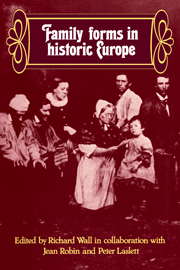Book contents
- Frontmatter
- Contents
- List of contributors
- Preface
- 1 Introduction
- 2 Two kinds of pre-industrial household formation system
- 3 ‘A large family: the peasant's greatest wealth’: serf households in Mishino, Russia, 1814–1858
- 4 The peasant family as an economic unit in the Polish feudal economy of the eighteenth century
- 5 The familial contexts of early childhood in Baltic serf society
- 6 Estonian households in the seventeenth and eighteenth centuries
- 7 Family and familia in early-medieval Bavaria
- 8 The property and kin relationships of retired farmers in northern and central Europe
- 9 Pre-industrial household structure in Hungary
- 10 The reconstruction of the family life course: theoretical problems and empirical results
- 11 The changing household: Austrian household structure from the seventeenth to the early twentieth century
- 12 Does owning real property influence the form of the household? An example from rural West Flanders
- 13 The evolving household: the case of Lampernisse, West Flanders
- 14 The composition of households in a population of 6 men to 10 women: south-east Bruges in 1814
- 15 The importance of women in an urban environment: the example of the Rheims household at the beginning of the Industrial Revolution
- 16 The household: demographic and economic change in England, 1650–1970
- 17 Family and household as work group and kin group: areas of traditional Europe compared
- References
- Index
15 - The importance of women in an urban environment: the example of the Rheims household at the beginning of the Industrial Revolution
Published online by Cambridge University Press: 05 November 2011
- Frontmatter
- Contents
- List of contributors
- Preface
- 1 Introduction
- 2 Two kinds of pre-industrial household formation system
- 3 ‘A large family: the peasant's greatest wealth’: serf households in Mishino, Russia, 1814–1858
- 4 The peasant family as an economic unit in the Polish feudal economy of the eighteenth century
- 5 The familial contexts of early childhood in Baltic serf society
- 6 Estonian households in the seventeenth and eighteenth centuries
- 7 Family and familia in early-medieval Bavaria
- 8 The property and kin relationships of retired farmers in northern and central Europe
- 9 Pre-industrial household structure in Hungary
- 10 The reconstruction of the family life course: theoretical problems and empirical results
- 11 The changing household: Austrian household structure from the seventeenth to the early twentieth century
- 12 Does owning real property influence the form of the household? An example from rural West Flanders
- 13 The evolving household: the case of Lampernisse, West Flanders
- 14 The composition of households in a population of 6 men to 10 women: south-east Bruges in 1814
- 15 The importance of women in an urban environment: the example of the Rheims household at the beginning of the Industrial Revolution
- 16 The household: demographic and economic change in England, 1650–1970
- 17 Family and household as work group and kin group: areas of traditional Europe compared
- References
- Index
Summary
Introduction
Little is yet known about the history of the urban family. The study that I have carried out over the last few years into the social and demographic history of the town of Rheims in Champagne will eventually illuminate the fundamental characteristics of a non-rural society before the Industrial Revolution. I propose here to analyse the census of 1802, which has survived in its entirety, for this town of 30,200 inhabitants. This document provides the closing point for the family reconstitution of all Rheims parishes beginning in 1660. The opening of the nineteenth century makes a fitting end to the study. By then, the tumultuous revolutionary period was over, and the town had recovered the demographic prosperity it had enjoyed in 1780. Yet no one suspected at the time that the century which was about to begin was to result in unprecedented population increase and the modification of all demographic and economic structures.
The economic situation at the beginning of the nineteenth century
Rheims in 1802 remained fundamentally as it had been under the Ancien Régime: it was dominated by an intensive artisan-based textile industry involving the preparation and weaving of wool. In 1790 the town had contained 1,300 master drapers as well as serge, buttermuslin, and cheesecloth weavers working more than 3,000 looms among them. Those not actually concerned with weaving combed, span, and set the warp for the looms. Men and women had their separate tasks.
- Type
- Chapter
- Information
- Family Forms in Historic Europe , pp. 475 - 492Publisher: Cambridge University PressPrint publication year: 1983
- 12
- Cited by



